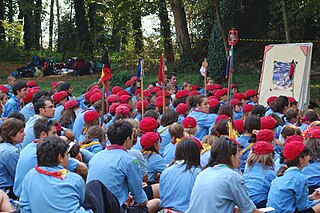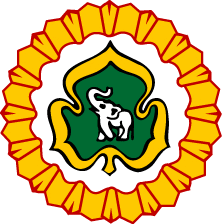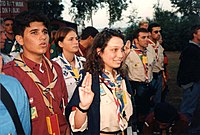
Scouting, also known as the Scout Movement, is a worldwide youth social movement employing the Scout method, a program of informal education with an emphasis on practical outdoor activities, including camping, woodcraft, aquatics, hiking, backpacking, and sports. Another widely recognized movement characteristic is the Scout uniform, by intent hiding all differences of social standing in a country and encouraging equality, with neckerchief and campaign hat or comparable headwear. Distinctive uniform insignia include the fleur-de-lis and the trefoil, as well as merit badges and other patches.

Brownies are the section in the Girl Guides organization for girls aged seven years old to ten years old. Exact age limits are slightly different in each organization.

The two-finger salute is a salute given using only the middle and index fingers, while bending the other fingers at the second knuckle, and with the palm facing the signer. This salute is used by the Polish Armed Forces, other uniformed services in Poland, and, in some countries, the Cub Scouts.

Cub Scouts, Cubs or Wolf Cubs are programmes associated with Scouting for young children usually between 7 and 12, depending on the organisation to which they belong. A participant in the programme is called a Cub. A group of Cubs is called a "Pack".

Cub Scouting is part of the Scouting program of the Boy Scouts of America (BSA), available to boys and girls from kindergarten through fifth grade, or 5 to 10 years of age and their families. Its membership is the largest of the five main BSA divisions. Cub Scouting is part of the worldwide Scouting movement and aims to promote character development, citizenship training, personal fitness, and leadership.

The Scout Promise is a spoken statement made by a child joining the Scout movement. Since the publication of Scouting for Boys in 1908, all Scouts and Girl Guides around the world have taken a Scout promise or oath to live up to ideals of the movement, and subscribed to a Scout Law. The wording of the Scout Promise and Scout Law have varied slightly over time and from country to country. Although most Scouting and Guiding organizations use the word "promise", a few such as the Boy Scouts of America tend to use "oath" instead.

The World Scout Emblem is the emblem of the World Organization of the Scout Movement and is worn by Scouts and Scouters around the world to indicate their membership. Each national Scout organization determines the manner in which the emblem is worn.
Scouting and Guiding in mainland China was reported as banned with the establishment of the People's Republic of China (PRC) by the Communist Party since 1949. Instead, the Young Pioneers of China and the Communist Youth League, led by the Communist Party, have become the dominant youth organization in mainland China for younger and older youth, respectively. However, China now has multiple and originally separate Scouting activities within its borders. In 2004, the Scout Club of Hainan (海南童子军俱乐部), borrowing heavily from Scouting in terms of emblems, uniforms and activities, was founded in Hainan Province; it is, however, not affiliated with worldwide Scouting. An attempt to organize a nationwide Scouting organization in Wuhan was ended by the government in 2004. The Scout Association of the People's Republic of China (中华人民共和国童军总会), founded in 2008 serves Venture Scouts in both genders as well as Rover Scouts. The Rover Explorer Service Association operate groups in China.

The Kenya Scouts Association is the national Scouting association of Kenya. Scouting was founded in British East Africa in 1910 and became a member of the World Organization of the Scout Movement in 1964. It has 323,929 members.

The Scout method is the informal educational system used in the Scouting Movement. The aim of Scouting is character training with the goal of helping participants become independent and helpful, and thereby become "healthy, happy, helpful citizens".
Beavers is a programme associated with some Scouting organisations generally for children aged 5/6 to 7/8 who are too young for the Cub programme.

Scouting and Guiding in Saint Helena, Ascension and Tristan da Cunha is administered by the United Kingdom Scout Association and Girlguiding UK, due to Saint Helena, Ascension and Tristan da Cunha's affiliations as a British Overseas Territory.
The Scout Movement in Spain consists of about 30 independent associations, most of them active on the regional level. Due to the regionalisation of Spain, even the larger nationwide associations are divided into regional sub-associations with individual emblems, uniforms and Scout programs.

Religion in Scouting and Guiding is an aspect of the Scout method that has been practiced differently and given different interpretations in different parts of the world over the years.

The Sri Lanka Girl Guides Association is the national Guiding organization of Sri Lanka. It serves 54,824 members. Founded in 1917, the girls-only organization became a full member of the World Association of Girl Guides and Girl Scouts in 1951.

The left-handed Scout handshake is a formal way of greeting other Scouts and is used by members of Scout and Guide organizations around the world. The handshake is made with the hand nearest to the heart and is offered as a token of friendship. In most situations, the handshake is made firmly, without interlocking fingers, and many organizations only use this handshake when both people are in uniform. There are some variations of the handshake between national Scouting organizations and also within some program sections.

Scouting and Guiding in Gibraltar exist as branches of the parent organisations in the United Kingdom.

Girl Guides is a worldwide movement, originally and largely still designed for girls and women only. The movement began in 1909, when girls requested to join the then-grassroots Boy Scout Movement.

The Grand Howl is a ceremony used by Cub Scouts and Brownies. It was devised by Robert Baden-Powell, the author of the scouting guide Scouting for Boys, and is based on the Mowgli stories in Rudyard Kipling's Jungle Book. In the ceremony, Cubs act out the wolves greeting Akela, the "Old Wolf", at the Council Rock and are reminded of the Cub Scout Promise. Baden-Powell also created a Grand Howl for Brownie Guides, which was in imitation of an owl instead of a wolf. It has been used as an opening and closing ceremony as well as a method of conveying thanks or appreciation by all sections of Scouting.



















